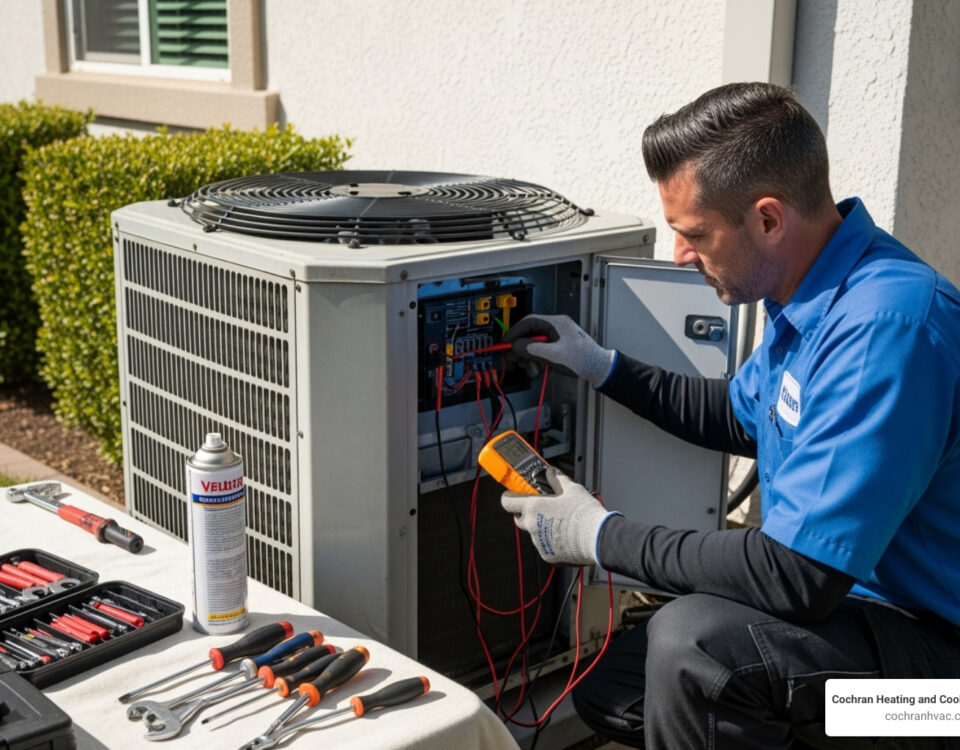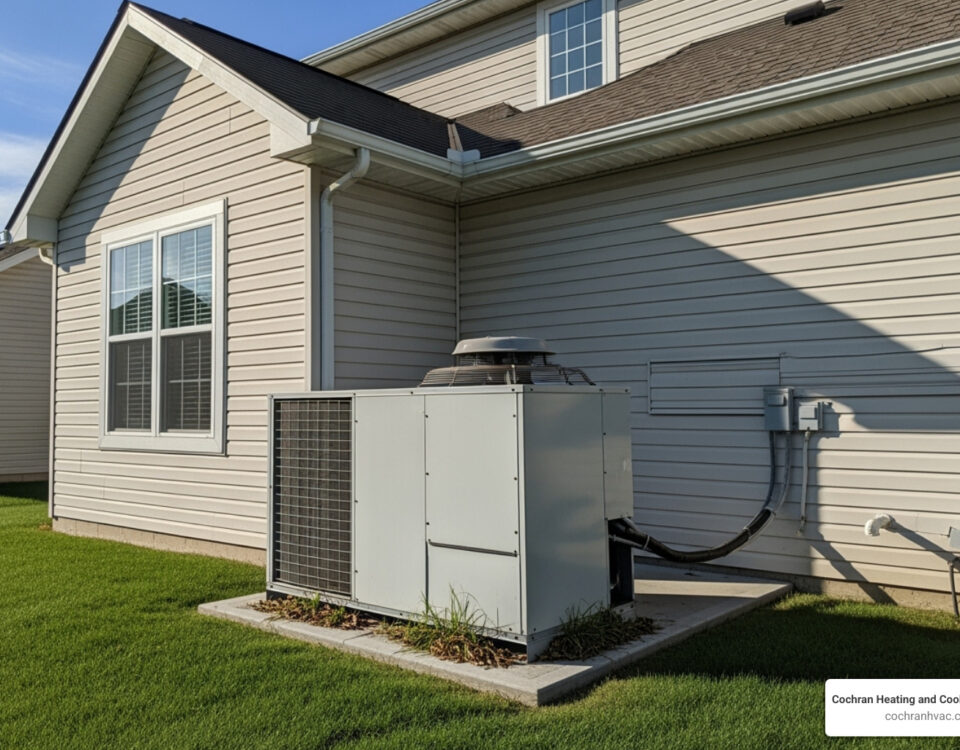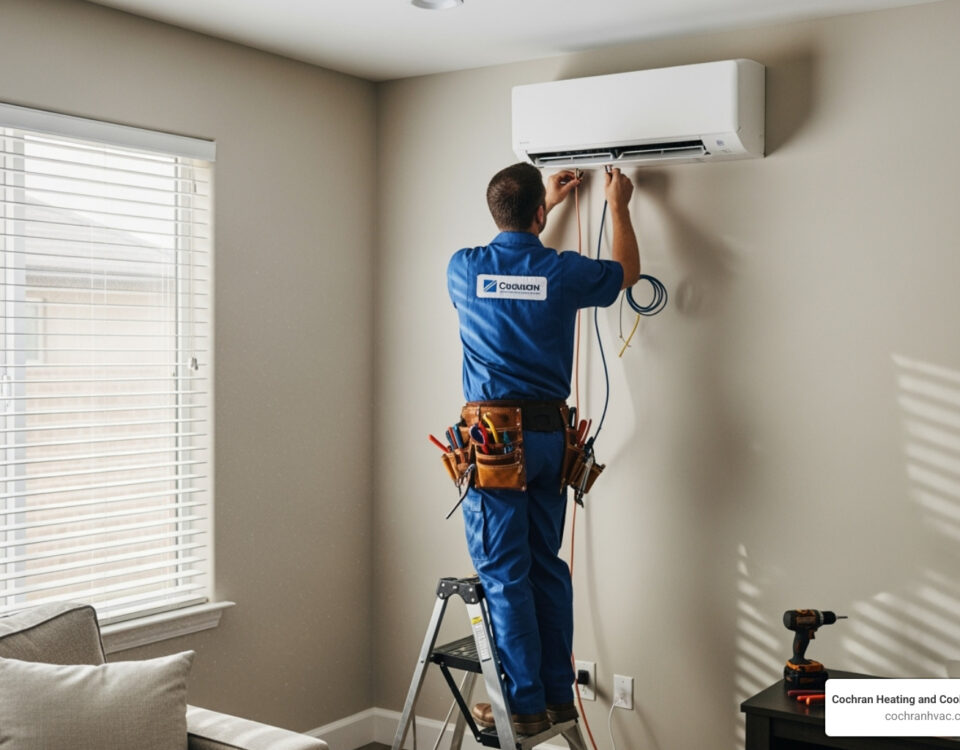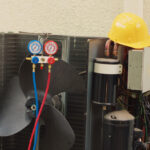
Common HVAC Electrical Issues in Irwin Residences
June 24, 2025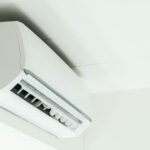
Solving AC Condensate Line Blockages in North Huntingdon
July 1, 2025If your home in Greensburg isn’t cooling like it should, your thermostat might be the problem. As central as it is to keeping your AC running right, the thermostat is often overlooked. But when it sets the wrong temperature or stops responding, it can make your space uncomfortable fast. Homeowners often assume the issue lies with the system itself, but many times the trouble can be traced back to that small device on the wall.
Knowing how to spot and handle thermostat issues goes a long way in avoiding more costly problems down the line. A faulty thermostat can cause your AC to cycle too often, not turn on at all, or keep running long after the space is cool. By learning to recognize early warning signs and taking simple first steps, you can keep your system working properly through the peak of summer.
Understanding Common AC Thermostat Issues
When your AC doesn’t seem to be working right, the problem might not be the cooling system at all. The thermostat could be misreading the temperature, failing to send signals, or having power supply problems. These issues often come from wear and tear over time, battery failure, or even a poor placement on the wall where it gets too much sun or isn’t near central airflow. All of these can throw off the thermostat’s ability to control your AC effectively.
Some homeowners notice that their AC just never shuts off. Others might realize the temperature inside feels nothing like what the thermostat is set to. In many of these cases, dust buildup inside the thermostat, loose wiring, or even outdated technology contributes to the problem. If your thermostat settings seem right but your AC behaves strangely, it’s likely something internal needs attention.
Smart thermostats can create their own unique issues. While they offer convenience and energy savings, they also rely on software that can bug out. A power glitch, Wi-Fi disruption, or outdated firmware can interfere with performance. On the other hand, outdated manual thermostats may struggle with calibration or simply stop reading temperatures accurately.
Homeowners often overlook thermostat problems because they feel small until they cause bigger ones. If your system is blowing warm air when it should be cooling, or runs in short, uneven cycles, the thermostat may not be sending the right signals. Knowing what to look for can help you act sooner.
Identifying Symptoms Of A Faulty Thermostat
Catching the signs of thermostat trouble early helps prevent bigger AC problems later. Here are six common symptoms that suggest your thermostat might not be working properly:
1. Inconsistent Temperatures – One room feels cold while another is still warm, even though the system is set to one temperature.
2. Short Cycling – Your AC kicks on and off more frequently than normal, often before reaching the desired temperature.
3. The AC Won’t Turn On – If your system won’t start, the thermostat may be failing to trigger it.
4. Unresponsive Controls – You change the temperature, but your system doesn’t adjust at all.
5. Blank Screen – Digital thermostats that shut off entirely may have battery or electrical issues.
6. Rising Energy Bills – A faulty thermostat can lead to overworking the system, using more energy to do less cooling.
Here’s an example: A Greensburg homeowner sets their thermostat to 72 degrees, but even after running the AC for an hour, the house still feels warm. When they check the thermostat, everything looks fine, but the actual room temperature is still climbing. It turns out the thermostat had dust buildup inside and wasn’t properly registering the indoor temperature, making the AC work harder than it needed to.
These signs don’t always mean something serious is wrong, but they do suggest it’s time to investigate. Ignoring them can lead to higher utility costs, reduced comfort, and extra wear on your AC. Thermostat troubles often get worse if left unchecked.
Troubleshooting Steps for Homeowners
Before calling in a technician, there are a few basic steps you can take to check if your thermostat is working correctly. These initial checks don’t require any tools or experience. They just help rule out the obvious causes. If a quick setting adjustment fixes the problem, you might avoid a service visit altogether.
Start with the thermostat settings. Make sure it’s set to “cool,” not just “fan” or “off.” Accidental bumps or power outages can reset a thermostat or change its mode. Next, check the temperature setting. Sometimes, it’s just set too high, and lowering it by a couple degrees will trigger the AC to kick in.
If the screen is blank, swap the batteries. Even thermostats that appear hardwired may still rely on backup batteries. If new batteries bring it back to life, that could solve the issue entirely. You should also take a look at the breaker box. A tripped breaker that controls the HVAC system can cause thermostat failure without affecting the rest of your home’s power.
Here are a few key things to review:
– Confirm the thermostat is set to “cool” and the desired temperature is lower than the current room temperature
– Replace thermostat batteries if the screen is dim or blank
– Make sure the thermostat is clean; dust inside the unit can affect internal sensors
– Check if the circuit breaker for the HVAC system is tripped
– Inspect the faceplate to ensure it’s securely attached; a loose cover might prevent proper function
If your unit is older or seems to need frequent resets, it could be a sign the system needs more than a basic fix. At that point, it’s smart to move to the next step and call in one of our professionals to review the system as a whole.
When To Call In the Professionals
Some thermostat problems go beyond what you can safely or reasonably fix on your own. If basic troubleshooting doesn’t solve the issue, or if your AC behaves oddly even after checking settings and power supply, it’s time to get professional help. Problems involving wiring, failing components, or system mismatches require proper diagnosis.
You should also contact someone if the thermostat is set correctly, powered, and appears functional, yet your AC unit still isn’t responding as it should. That mismatch usually indicates a communication issue between the thermostat and the HVAC system. It could be the wiring, a component failure, or something inside the air handler or outdoor condenser.
Here are some clear signs it’s time to bring in our professionals in Greensburg:
– The AC turns on but doesn’t cool the space effectively
– The thermostat settings reset overnight or after brief power losses
– You’ve replaced batteries and cleaned the unit, but the same problems persist
– You installed a new thermostat and cooling issues began shortly after
– Cooling cycles have become too short or too long, despite consistent indoor temps
If your home still uses a mechanical thermostat, it might be time for an upgrade. A newer model can offer better control and more consistent operation. Our technicians can help match your home’s cooling system with the right thermostat setup and ensure it’s installed correctly.
Ensuring Long-Term Thermostat Health
Keeping your thermostat working reliably doesn’t demand much effort, but it does require steady habits. Regular upkeep can help you avoid performance issues during high-demand times.
First, clean your thermostat every few months. Dust and debris can gather inside, interfering with internal components and readings. A dry cloth can usually handle the job. Avoid using cleaners or solutions that might drip inside.
Next, check where your thermostat is located. If it’s near a vent, window with direct sunlight, or heat-producing appliance, it might not get an accurate reading of room temperature. Even large furniture positioned too close can block airflow and throw off performance.
Routine AC maintenance also plays a key role. When our technicians inspect your HVAC system, they review the thermostat’s function too. This included catching issues like weak batteries, miscalibration, or outdated firmware in smart units. Taking these preventive steps helps protect both your thermostat and the performance of your entire cooling system.
Tips for Greensburg homeowners to maintain a healthy thermostat:
– Wipe the thermostat surface and vents regularly with a dry cloth
– Keep the space around it free from direct sunlight and heat sources
– Replace batteries at least once per year or when the display dims
– Avoid frequent temperature adjustments throughout the day
– Take small concerns seriously to prevent larger breakdowns later on
These small habits can help extend the life of your thermostat and maintain better cooling control during warmer months.
Keep Your AC Running Smoothly In Greensburg
Thermostat issues can start small but grow into major AC problems when ignored. Learning how to identify these early signs and understanding what steps to take can help homeowners in Greensburg stay ahead of discomfort and surprise repairs. Responding early is one of the simplest ways to protect your cooling system through the summer.
If your AC system is not operating the way it should and you suspect thermostat trouble, it’s time to act. Whether the problem is mechanical, electrical, or environmental, our professionals can provide the solutions needed to get your system back on track. With routine care and prompt repair when necessary, your thermostat and AC unit can continue to deliver consistent comfort all season.
Keep your home cool and comfortable by scheduling AC maintenance in Greensburg with professionals who understand the importance of proactive care. Regular upkeep helps prevent minor issues from developing into expensive repairs and ensures your system operates efficiently on hot days. Trust Cochran Heating and Cooling to deliver the expert service your AC deserves. For a quick estimate or to book a service visit, please contact us today.


